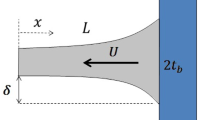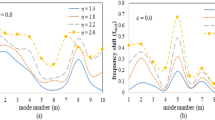Abstract
The vorticity in the wake flow behind bluff bodies can be used to generate undulating motion of polymeric flexible plates. When the plates carry piezoelectric cells, the strain energy resulting from flapping can be converted into electricity. The undulating motion of cantilevered plates in the wake of a bluff body has been described in a few studies; less information was given on the flow pattern and fewer on the influence of the geometric parameters. In this study, a polyethylene terephthalate thin plate was clamped to a square cylinder and placed in a water tunnel and the Reynolds number based on the square cylinder was set from around 1500 to 20,000. The plate deflection and related flow pattern were captured at both 5000 and 500 frames per second using two different high speed cameras. Modal decomposition, strain energy and flapping power calculation were carried out from the deflection data. The flow vectors were computed using the particle image velocimetry software PIVlab. Strain energy is maximized when higher order modeshapes occur which is only the case for longer plates because of the lower natural frequencies resulting in an increased plate-wake interaction. The plate width is an important parameter as wider plates witness strain energy wastage owing to torsion and plates that are too narrow undergo out of plane bending. Longer plates yield greater power output as long as the bending pattern is kept two-dimensional. The strain nodes have a more significant shift in positions along the beam for longer plates. This may result in significant charge cancellation within the piezoelectric cells.




















Similar content being viewed by others
References
Akaydın HD, Elvin N, Andreopoulos Y (2010) Wake of a cylinder: a paradigm for energy harvesting with piezoelectric materials. Experiments in Fluids 49(1):291–304
Akaydin HD, Elvin N, Andreopoulos Y (2012) The performance of a self-excited fluidic energy harvester. Smart Materials and Structures 21(2):025007
Allen JJ, Smits AJ (2001) Energy harvesting eel. J Fluids Struct 15:629–640
Binyet E, Huang C-Y, Chang J-Y (2018) Characterization of a vortex-induced vibrating thin plate energy harvester with particle image velocimetry. Microsyst Technol 24:4569
Erturk A, Inman DJ (2011) Piezoelectric energy harvesting. Wiley, Hoboken. ISBN 978-0-470-68254-8
Erturk A, Tarazaga PA, Farmer JR, Inman DJ (2009) Effect of strain nodes and electrode configuration on piezoelectric energy harvesting from cantilevered beams. J Vib Acoust 131(1):0110101–01101011. https://doi.org/10.1115/1.2981094
Frisch-Fay R (1962) Flexible bars. Butterworths, London
Lighthill MJ (1971) Large-amplitude elongated-body theory of fish locomotion. Biol Sci 179(1055):125–138
Okajima A (1982) Strouhal numbers of rectangular cylinders. J Fluid Mech 123:379–398
Raffel M, Willert CE, Wereley Steve T, Kompenhans J (1998) Particle image velocimetry a practical guide, 2nd edn. Springer, Berlin. ISBN 978-3-540-72307-3
Shi S, New TH, Liu Y (2014) Effects of aspect-ratio on the flapping behavior of energy-harvesting membrane. Exp Thermal Fluid Sci 52:339–346
Shu YC, Lien IC (2006) Efficiency of energy conversion for a piezoelectric power harvesting system. J Micromech Microeng 16:2429–2438
Sonalla MI (1989) Vibrations of cantilever beams with various initial conditions. Dissertation, The Ohio State University
Taylor GW, Burns JR, Kammann SM, Powers WB, Welsh TR (2001) The energy harvesting eel: a small subsurface ocean/river power generator. IEEE J Ocean Eng 26(4):539–547
Thielicke W (2014) The flapping flight of birds: analysis and application. https://doi.org/10.13140/RG.2.2.18656.94728
Timoshenko S, Goodier JN (1951) Theory of elasticity. McGraw-Hill The Maple Press Company, York, USA. ISBN 10: 007064270
Acknowledgements
Many thanks to Jospeh Lee and Kevin Huang from Long Win Science and Technology Corporation for putting at our disposal a 5000 frames per second high speed camera.
Author information
Authors and Affiliations
Corresponding author
Additional information
Publisher's Note
Springer Nature remains neutral with regard to jurisdictional claims in published maps and institutional affiliations.
Rights and permissions
About this article
Cite this article
Binyet, E., Huang, CY. & Chang, JY. Water tunnel study of a cantilever flexible plate in the wake of a square cylinder. Microsyst Technol 26, 3435–3449 (2020). https://doi.org/10.1007/s00542-020-04901-x
Received:
Accepted:
Published:
Issue Date:
DOI: https://doi.org/10.1007/s00542-020-04901-x




